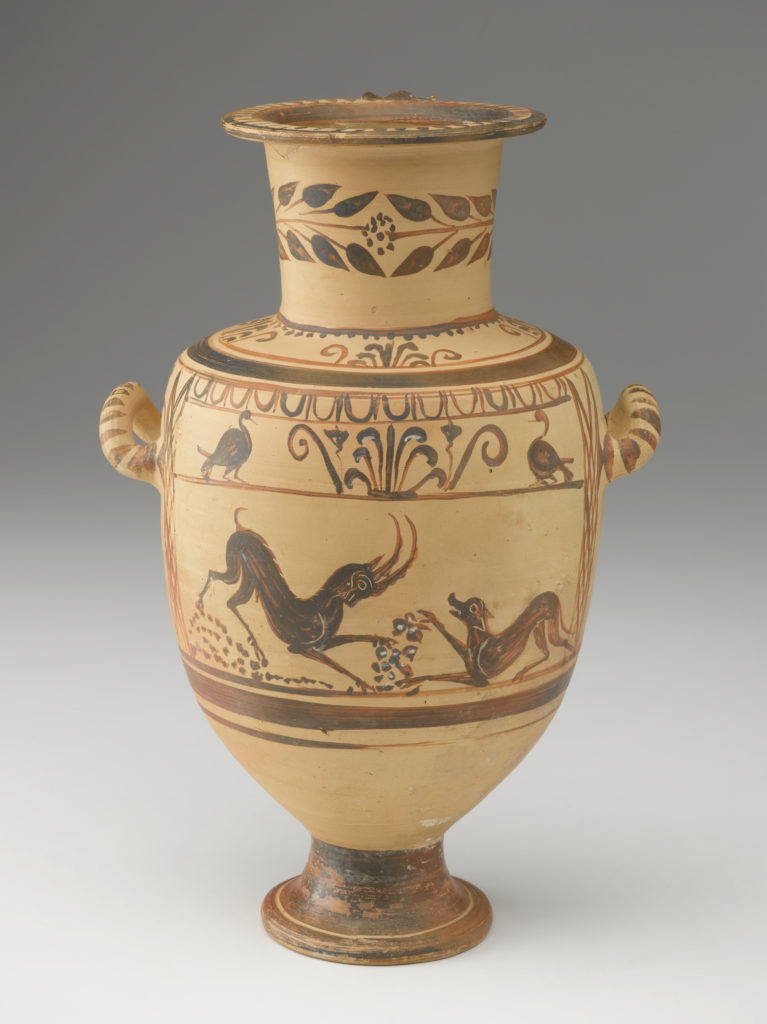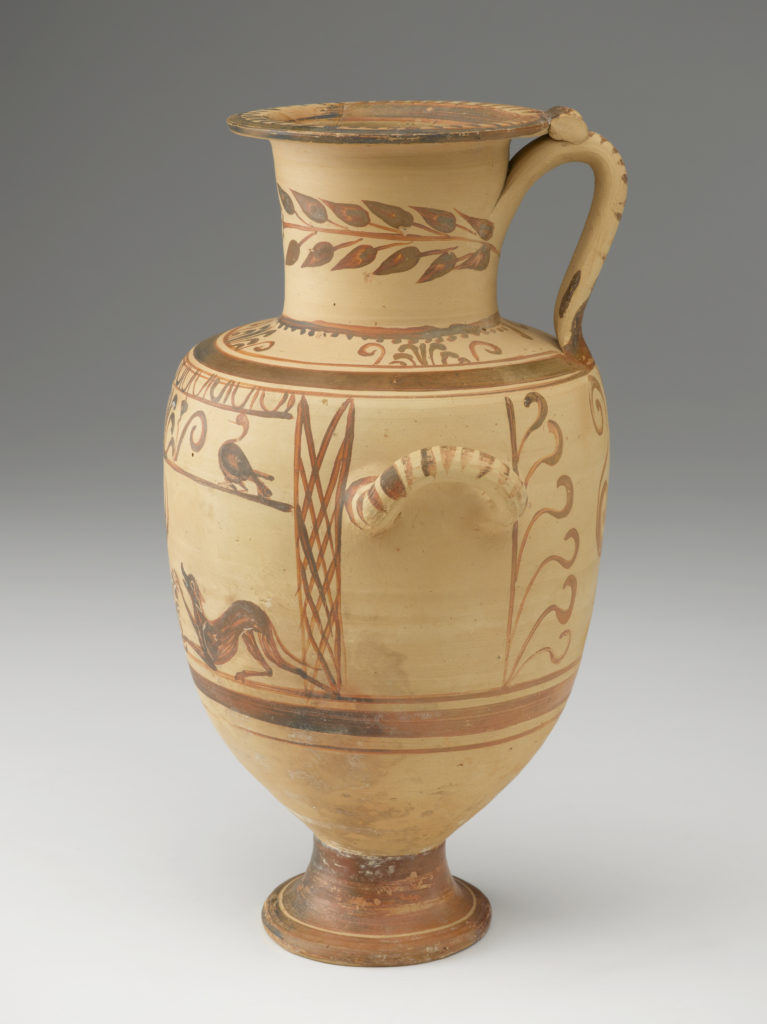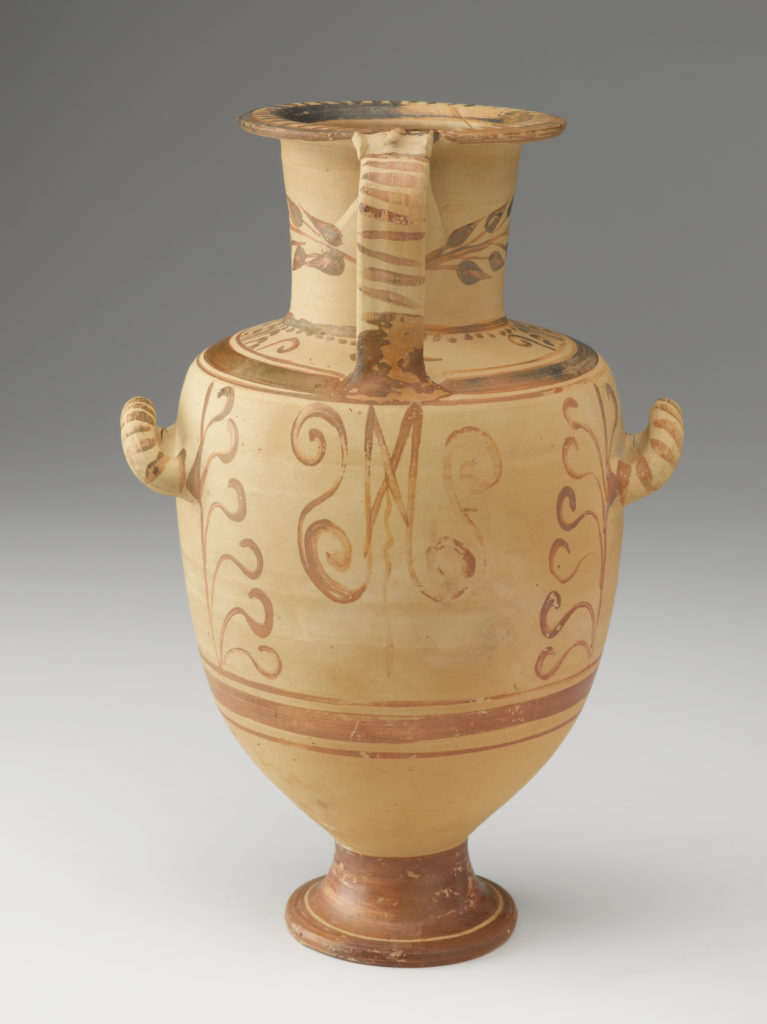Hadra Hydria (work of art)
Artwork Info
About
Key Ideas
- Hadra Hydria is shaped like a traditional hydria vase (typically used for water storage), but this vessel was actually used to store a deceased person’s ashes.
- The vase was likely found in the Hadra cemetery in Alexandria, Egypt. This ancient cemetery was used by Greek settlers in Egypt during the Hellenistic Period (323 to 31 BCE).
- Alexandria was a major city in Egypt. It was one of the many colonies founded by Alexander the Great during his military campaigns in the eastern Mediterranean, Egypt, the Middle East, and part of Asia.
- The decorations on the vase were made by applying black glaze over a yellowish-brown clay. The details were created with white paint. The designs include two water birds, several ornamental patterns, and a scene depicting a dog barking at an ibex (a type of wild goat).
- Hadra vases were made in Crete, Greece, and then exported to Egypt.
Learn More
Hadra Hydria is shaped like a hydria, a type of Greek vase that was used for collecting and pouring water. This vase, however, was used as a cinerary urn (a container for a deceased person’s ashes). “Hadra” is the modern name for an ancient cemetery, or necropolis (meaning “the city of the dead’’) in Alexandria, Egypt.
The Hadra cemetery was actively used during the early Hellenistic Period. The Hellenistic Period is the time between Alexander the Great’s death and the beginning of the Roman Empire (323 to 31 BCE). Alexander the Great was a king and general who ruled the kingdom of Macedon (north of Greece). He conquered the eastern Mediterranean, Egypt, the Middle East, and parts of Asia. The ancient city of Alexandria, Egypt, was one of many cities named for Alexander the Great. After Alexander died, Egypt was given to Ptolemy (one of his trusted generals). Ptolemy and his descendants ruled Egypt until 30 BCE. During their rule, many Greek merchants and settlers came to Alexandria and lived there with the Egyptian locals. The Hadra cemetery was reserved for these Greek settlers. Many of the vases that were found in the Hadra cemetery were engraved with the name of the deceased, their date of death, and the signature of the person who carved the details into the vase.
Hadra Hydria is decorated with animal scenes and decorative patterns. The decorations were made by applying black glaze over a golden buff (yellowish-brown) clay. White paint was applied to create details. A laurel branch is painted on the neck (the narrow part that connects the body of the vase to the top opening). On the body of the vase there are two sections of animal scenes. In the upper section, two water birds face an upright palmette (palm leaf design) on opposite sides. The palmette is framed by flowers and vines. In the lower section, a long-horned ibex (a type of wild goat) faces off against a hunting dog in a setting with rocky ground. Even though these decorations are painted on a cinerary urn, they don’t have any meaning associated with burial.
Scholars once believed that Hadra vases were produced locally in Egypt because so many of them were found in and around Alexandria. Many more similar vases, however, have been found on the island of Crete, Greece. After analyzing and comparing the clay, scholars now believe that vases like Hadra Hydria were produced on Crete and then exported to Egypt.
Additional Resources
Resources for Teachers:
- Read an article about Ptolemaic Egypt.
- Explore a website to learn about burial practices in different periods of ancient Egyptian history.
- Explore a webpage about dogs in ancient Greece.
Resources for Students:
- Watch a video about Hadra hydria vases.
- Watch a video tour of Alexandria, Egypt, in Assassins Creed: Origins.
- Watch a video about the Hellenistic Period.



